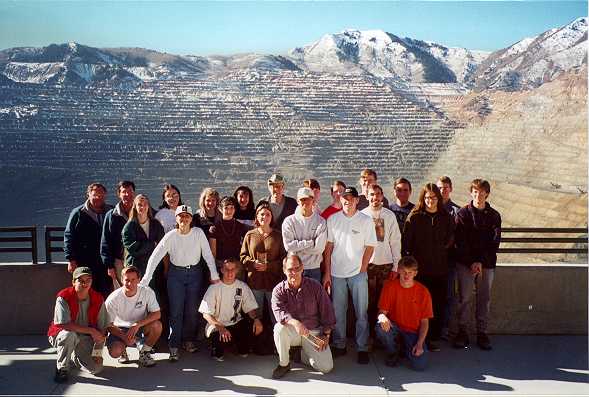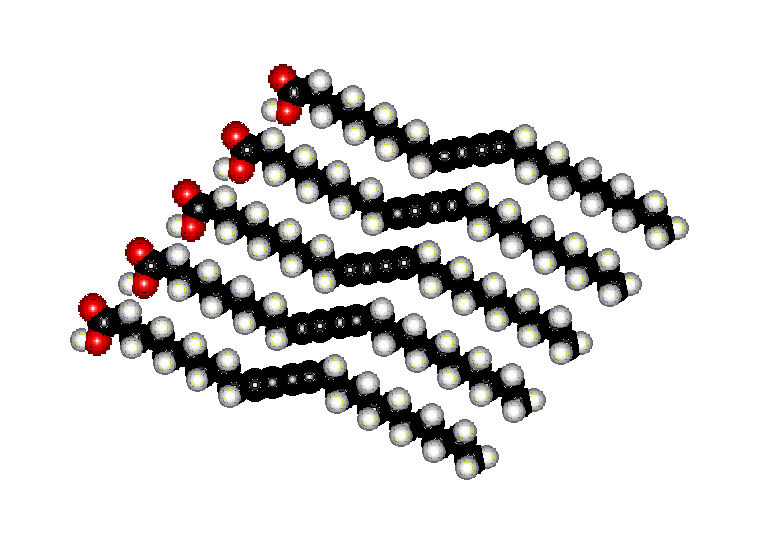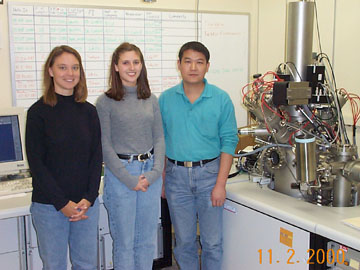






|  |
 |
 |
 | |
 |
Summer Analytical Chemistry Program
The University of Delaware
Department of Chemistry & Biochemistry
Professor Thomas P. Beebe, Jr., Program Director

Executive Summary. Each Summer, we select 20 of the Delaware Valley's top high school students and two high school teachers, to participate in an 8-week-long summer program of Analytical Chemistry for High School Students and Teachers, in which the students study a rigorous upper-division college-level Quantitative Chemical Analysis course. Near the middle of this summer period, the students propose and carry out an environmental analytical chemistry research project of their own choosing, in which they use their new skills and knowledge to solve a small research project in the field of analytical chemistry. The high school teachers function as lab assistants and discussion leaders, taking their newly learned skills, laboratory experiments, and confidence back to their high schools where they can influence a large number of students. The program was begun in Salt Lake City at the University of Utah, where it ran successfully for 10 years, and had an impact on approximately 200 students and 20 teachers. In addition to support from the University of Delaware, the program has been funded by the prestigious Howard Hughes Medical Institute.
Background.The State of Delaware, Southeastern Pennsylvania and Northeastern Maryland produce many extremely capable, ambitious young women and men interested in careers in chemistry and related fields. Lacking the appropriate challenges, many of these high-ability students are lured away from careers in science and medicine, or worse, away from academic pursuits entirely. A challenging program, providing elements of quantitative chemistry and research, is needed for students who have completed AP chemistry in high school. This novel program is designed to expose the students to modern analytical chemistry (the science of making and understanding a chemical measurement), and afford them the opportunity to conduct their first research project in some area of analytical chemistry. We have ample evidence that this excites them to pursue careers in science, engineering and medicine. The benefits to society and to our young people can be enormous when we identify ambitious students and provide them an avenue to express their talents early on.
Impact of high school teachers. One very important aspect of the program is the use of high school teachers in the role that is traditionally filled by advanced graduate teaching assistants. The high school teachers conduct daily homework discussion sessions prior to the day's lecture by chemistry faculty member and program director, Thomas P. Beebe, Jr.
Table 1. Schedule for Summer Portion of Program
|
Time |
Monday - Thursday |
Friday |
|
8:00 – 8:30 |
Discussion of homework assignment from previous lecture led by high school teachers; brief preparation for the day's lab led by high school teachers |
Review of week's lecture material by high school teachers |
|
8:30 - 9:45 |
Lecture by Professor Beebe; in-class demonstrations |
Quiz on the week's lectures |
|
9:45 – 10:00 |
Break |
|
|
10:00-12:30 |
Laboratory experiments; high school teachers act as lab assistants, perform labs along with students, prepare quantitative unknowns, and grade student lab reports. In the last 4 weeks of the program, the students carry out their Special Research Project. |
|
|
12:30 |
Dismissal |
Dismissal |
Together with Professor Beebe, the high school teachers also run and supervise the daily laboratory experiments, prepare quantitative chemical "unknowns," and advise the students. The teachers rotate through the program on a two-year schedule in which they are the apprentices in year 1, learning from the more experienced teacher, and then the leader in year 2, passing their experience on to the new apprentice. Professor Beebe has won local and national teaching awards for his work in this program. The teachers then return to their high schools, where they can have an enormous impact on the greatest number of students by introducing innovations into their own chemistry programs, and by helping to recruit new students into the next year of this program. Their involvement also builds their own confidence and self-esteem, making them better chemistry teachers.
Student-designed Special Research Project. A truly novel element of the proposed program is the Special Research Project. The students begin by taking a tour of the science section in the UD library, given by the science librarian. They will then begin to research their idea for this project. In an effort to mimic the actual procedure followed by many foundations that support research, the students prepare a Pre-proposal, stating their intended project, and the method by which they plan to do the analysis, including at least one reference. To achieve some iteration through feedback, we then return these pre-proposals with written comments and a personal interview, which the students then use to refine their ideas in the form of a 5-page Proposal, including the details of what equipment they will use, and where their chemicals will be bought (they must work within a budget). The proposals are then returned, again with comments. An example of a student-designed project is the measurement of the levels of PCBs (polychlorinated biphenyls, carcinogenic organic molecules used in electrical transformers) at electrical power sites. This program is professor-intensive; we interact extensively with the students for 5 contact hours daily, for 5 days per week. This is why these high school students perform well above college students taking a similar course (see Evaluation below).
Near the middle of the 8-week summer period, the students obtain their samples from the field and begin to carry out their proposed research. This research then continues, with faculty and teacher input, through the remainder of the summer. The project is then written up in the 7-page Research Report, which is meant to mimic the practice of publishing. Finally, the students again return to the campus in December for a Saturday morning of 15-minute oral presentations to their peers, designed to mimic the practice of attending scientific conferences and giving talks. Through this novel research project, we hope to instill an appreciation for making a good chemical measurement. We also hope to expose the students to some important and complex environmental issues in chemistry that will only become more important in society.
Field trips and involvement of local scientific community. During the late Summer and through Winter (when the students are now high school seniors or first-year college students), the students participate in field trips to local off-campus sites of relevance to chemistry. The Delaware Valley has a rich chemical and pharmaceutical history. Close ties between our Chemistry & Biochemistry Department and local scientists and engineers will be exploited to give students a first-hand view of the field. In addition, several UD faculty present Saturday morning research talks to the students. Through these and other experiences not mentioned, we hope to show these young scientists the many rewarding and challenging opportunities in the field of analytical chemistry and related disciplines.
Evaluation. Evaluation is based on a standardized pre- and post-test administered to the students. The post-test is the American Chemical Society Standardized Analytical Chemistry Exam. When this program was taught for 10 years at the University of Utah in Salt Lake City, our high school students typically averaged in the 75th to 85th national percentile, while a control group of college junior and senior chemistry majors averaged in the 65th to 70th percentile. In addition, there are typically 4 to 6 high school students who score in the 99th and 100th percentiles each year. This remarkable performance by high school students is better than that of many undergraduate college chemistry majors! Many of these students have gone on to careers in the chemical, biological, medical and environmental sciences at the best schools in the nation. Our graduates receive prestigious national scholarships and fellowships. Thus, results from previous years of this Summer Analytical Chemistry Program have provided convincing evidence that high school students can not only perform in a rigorous college-level analytical chemistry curriculum, but also that they can perform in the highest national echelons. In effect, we are challenging them to use their newly acquired skills to conduct a real environmental chemistry project that is of interest to them and the greater society. Thus, our evidence is clear that these high-ability high school students are ready for the challenges that our program provides.
Opportunities following the program. At the completion of the program, some of the top students are interviewed for undergraduate research positions in the federally funded research groups of University of Delaware faculty. This opportunity also functions as a very effective recruiting tool to bring the best students, tomorrow's leaders, into the fields of science, engineering and medicine.
|
Important Benefits of the Summer Analytical Chemistry Program |
• The Summer Analytical Chemistry Program has made important contributions to the university's teaching mission by identifying and exposing more than 200 young high school students to analytical chemistry at the university level.
• The program has greatly improved the quality of the science and engineering applicants and those that go into other science and engineering fields because it has functioned as a very effective recruiting mechanism for high-caliber science and engineering students.
• The program has improved the university's ability to recruit high caliber women applicants into careers that are traditionally dominated by men.
• The program helps the undergraduate research mission by identifying and placing the brightest, most creative students in research groups, both within the department and in other departments, where they publish their work in peer-reviewed scientific journals. The photo on back of this brochure shows Terra Hansen, center, and her team of researchers working on "molecule corrals" in the group of Dr. Beebe.
• It has now trained and professionally enhanced the teaching careers of more than 20 high school teachers. These high school teachers then go "back home" to multiply this impact in their high school classes, further improving the quality of the incoming applicant pool and raising the university's profile in the community.
• The program was also the basis for a recent award by the Camille & Henry Dreyfus Foundation of New York City for $42,000 to purchase new laboratory equipment in upper-level undergraduate teaching labs. Thus, the program's benefits spill over to other students at the university.

Program budget. The program has a yearly cost of approximately $50,000. These costs are for books, lab supplies, student tuition scholarships, recruiting, and teacher and faculty salaries.
Sources of current or previous funding support for this program
The Howard Hughes Medical Institute
George S. & Dolores Doré Eccles Foundation
John E. & Ruth E. Bamberger Foundation
R. Harold Burton Foundation
Camille and Henry Dreyfus Foundation of New York
The University of Delaware
How students can find out more about the program. Students are usually nominated to participate in the program by their high school teachers, although students may also contact us directly at the address below.
|
Professor Tom Beebe |
An application form and this brochure are available online at:
http://www.udel.edu/chem/beebe/summer.htm
